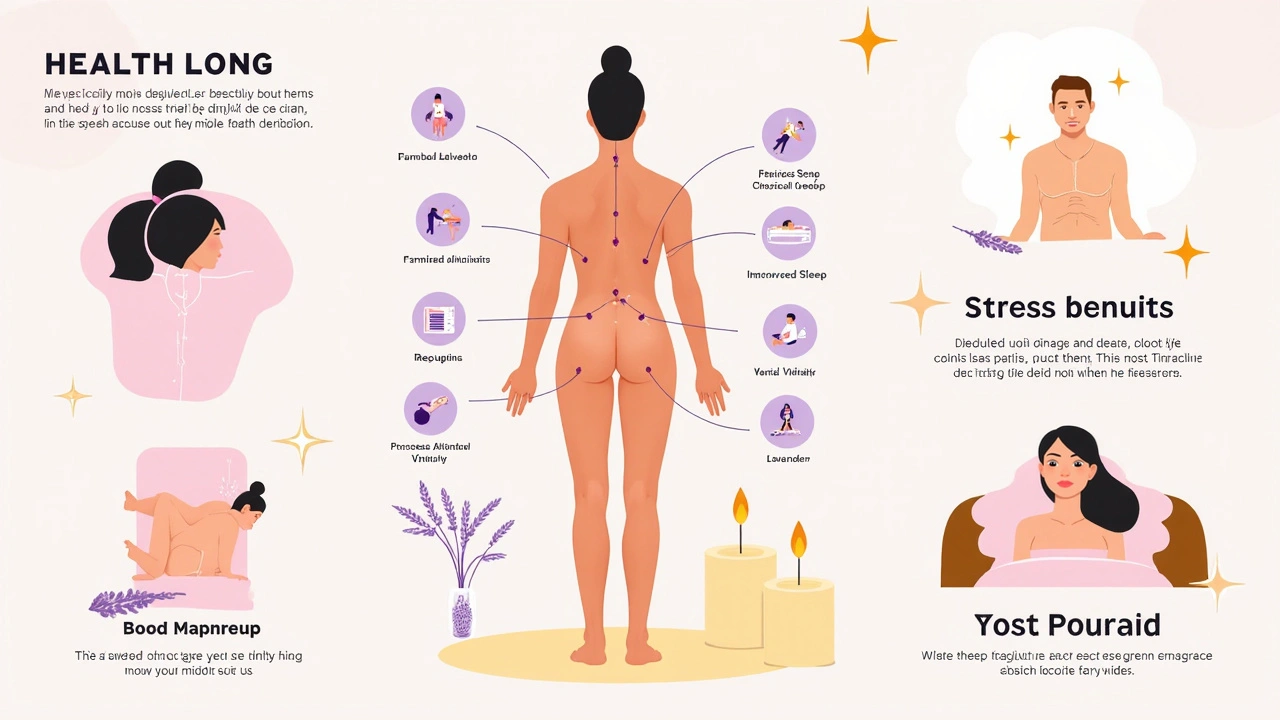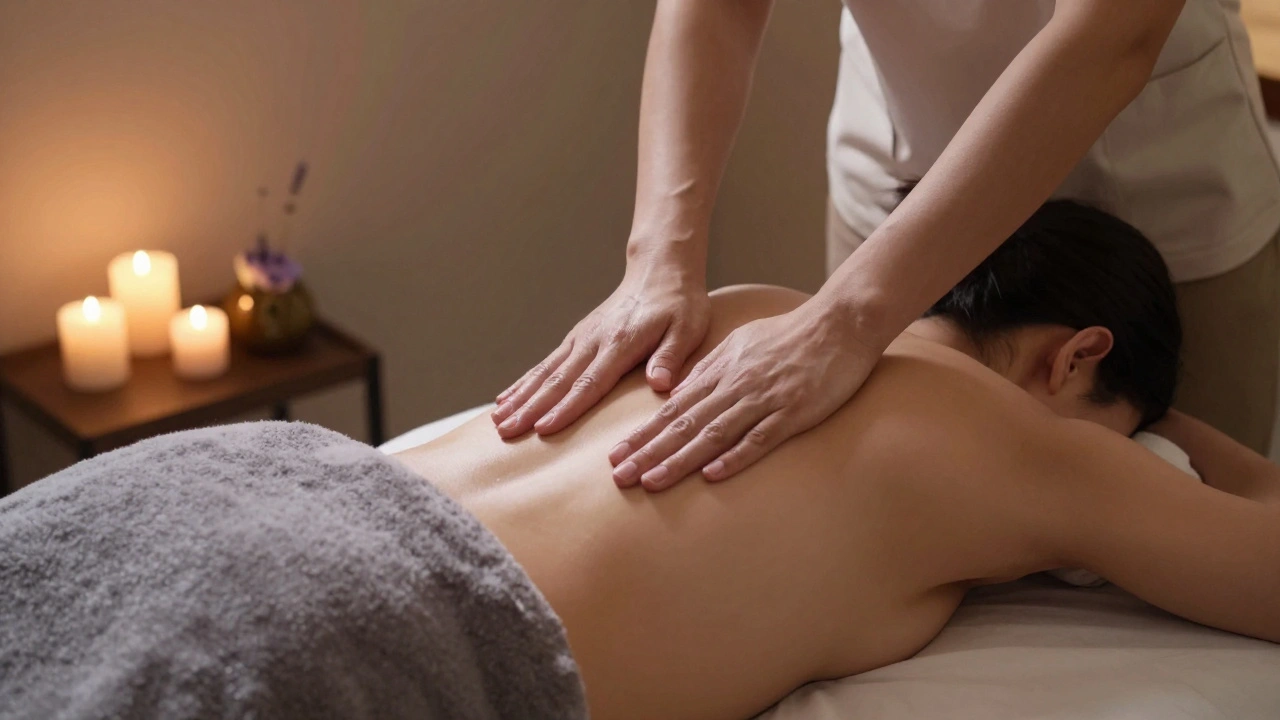Body Massage: Your Guide to Real Relaxation and Recovery

These days, everyone seems more stressed out than ever—tight muscles, sleepless nights, and endless to-do lists. That’s where a good body massage comes in. This isn’t just about feeling pampered for an hour. Science keeps showing that regular massage can lower your stress hormones, boost your immune system, and even help with stuff like anxiety or headaches.
Ever notice how you feel different after someone simply rubs your shoulders? That’s because massage sets off a chemical chain reaction in your body. It ups your serotonin and dopamine, which are the 'feel good' chemicals, and drops cortisol, the one linked to stress. You leave not just looser, but actually happier and more focused.
The real magic is that there’s no one-size-fits-all approach here. You can go for a deep tissue massage if your back feels like a rock or pick a gentler Swedish style if you’re just looking to relax. Knowing the difference saves you from a too-rough session or, on the flip side, one that barely scratches the surface of your muscle aches.
Some people avoid massage thinking it’s too expensive, awkward, or only for special occasions. But it’s actually one of the easier ways to hit pause on life and invest in yourself, no candles or mood lighting required. You just need to know what to expect and how to get the most out of it, and that’s exactly what you’ll learn in this guide.
- How Massage Actually Helps You
- Types of Massage and What They’re Good For
- Making the Most of Your Massage Sessions
- Straight Talk: Common Myths and Real Benefits
How Massage Actually Helps You
Body massage does a lot more than people usually think. Sure, it feels great, but there’s solid science behind why it works. For starters, massage improves your blood flow. That means more oxygen and nutrients move around your body, so muscles recover faster after a workout or long day at a desk.
You might be surprised to know that massage actually lowers the levels of stress hormone cortisol in your system. In a 2010 study, folks who had a 45-minute Swedish massage showed a 31% drop in cortisol. At the same time, their feel-good hormones—serotonin and dopamine—jumped up by as much as 28%.
Massage also tackles muscle pain and stiffness head-on. When someone works out those knots, your body releases endorphins, which act like natural painkillers. That’s why massage is often recommended for things like chronic back pain or tight shoulders from too much screen time.
Here’s a breakdown of what happens to your body after a body massage session:
| Benefit | How It Works |
|---|---|
| Lower stress | Decreases cortisol; boosts serotonin/dopamine |
| Muscle recovery | Improves blood flow and reduces tension |
| Pain relief | Triggers endorphin release |
| Better sleep | Lowers anxiety and relaxes nervous system |
| Stronger immune system | Increases natural killer cells in the body |
If you struggle with sleep, massage could be a game changer. Regular sessions help you fall asleep faster and sleep deeper by calming your nervous system. One study even found that people with insomnia slept better after just a few massage treatments.
Even your immune system gets a boost. Massage ups the production of certain white blood cells that fight off bugs and sickness, making you less likely to catch whatever’s going around the office. So massage isn’t only about pampering—it’s about taking care of your mind, body, and long-term health.
Types of Massage and What They’re Good For
All massages aren’t created equal. Walk into a spa, and suddenly you’re staring at a menu with names like “Swedish,” “Deep Tissue,” “Sports,” or “Aromatherapy.” It can get confusing fast, but picking the right one matters if you want real results. Here’s a no-nonsense rundown so you know what works for you.
- Body massage (the classic Swedish): This is what most people picture—long, sweeping strokes, kneading, and gentle tapping. It’s best for stress relief and getting that full-body chill. You leave feeling loose and calm, not sore or beat up.
- Deep tissue: Got knots in your shoulders or a back that feels stuck? Deep tissue goes for the muscles buried under layers of tension. Great for stubborn aches, old injuries, or after too much desk work. Heads up: You might be a little sore after, but it’s worth it if you need serious muscle relief.
- Sports massage: This one’s for athletes or anyone hitting the gym. It’s all about improving flexibility, targeting tight spots, and helping your body bounce back faster. Even weekend warriors can benefit—no need to run a marathon to book this one.
- Hot stone massage: Heated stones are placed on certain points on the body to loosen up tension. It’s like adding a mini heat pack to tired muscles. Perfect if you want deep relaxation without so much pressure.
- Thai massage: You stay fully clothed, and the therapist will stretch and move you into different positions. It’s a mix of massage and assisted yoga. If you’re feeling stiff and want to boost flexibility, this is it.
- Reflexology: Here, the focus is on your feet (sometimes hands and ears). The idea is that certain spots are linked to organs and systems in your body. Some folks swear by it for headaches, sinus issues, or just to melt away stress after a long day standing up.
Here’s a quick breakdown to make it easier to pick:
| Massage Type | Best For | Notes |
|---|---|---|
| Swedish | Relaxation, stress relief | The most popular, gentle enough for beginners |
| Deep Tissue | Chronic pain, tight muscles | Can be intense—expect some pressure |
| Sports | Injury prevention, muscle recovery | Targets specific muscle groups |
| Hot Stone | Deep relaxation, muscle tension | Uses heated stones combined with massage |
| Thai | Flexibility, energy | Stretching plus massage, done clothed |
| Reflexology | Foot pain, overall balance | Mainly on feet, good for stress relief |
If you’re not sure, just ask your therapist to walk you through the choices. There’s no shame in saying you don’t know what you need. The right fit comes down to what your body is craving: heavy-duty tension work, a gentle reset, or maybe just quiet time to recharge.

Making the Most of Your Massage Sessions
There’s a big difference between just showing up for a body massage and actually getting real results from it. If you're already carving out the time and spending the money, you want every minute to work for you. Here’s how you can squeeze the most out of every session.
Before you even walk in, think about what you need. Back pain? Stress? Trouble sleeping? Let the therapist know exactly why you’re there. Otherwise, it’s kind of like going to the doctor and not saying where it hurts. A good therapist will adjust the technique to match your needs—firm, light, spot-focused, or a mix.
Hydration makes a difference. Drink a glass of water an hour before your massage and again right after. Massage moves toxins around in your muscles so your body needs water to flush them out. If you skip this, you might feel a little sluggish afterward.
- Don’t eat a heavy meal right before you go. You'll feel better during the session and avoid any stomach issues.
- If you’re heading in after work or a workout, a quick shower helps—nobody likes feeling sticky, and it’s more relaxing.
- Leave your phone on silent or, even better, off. Distractions snap your brain out of relaxation mode.
- Share any injuries, allergies, or medical conditions with your therapist beforehand.
- If something hurts or makes you uncomfortable during the session, say something right away. Therapists want feedback so they can adjust.
After your massage, don’t just rush back to work or the gym. Take at least 10–15 minutes to chill out, stretch gently, or sip some water. This helps lock in the relaxed feeling and lets benefits soak in better.
| Tip | Why It Matters |
|---|---|
| Drink water before and after | Helps muscles recover and flushes out toxins |
| Communicate your goals | The therapist can focus on your main problem areas |
| Take it easy post-massage | Keeps your relaxed state longer, prevents dizziness |
| Avoid heavy meals pre-massage | Reduces discomfort for you during the session |
Studies show that people who get regular massages see lower blood pressure, less pain, and better sleep after just a few sessions. If you can, set up a schedule—say, once a month or every other week. Life gets busy, but consistency brings the most noticeable changes. So next time you’re booking, don’t treat it like a one-and-done treat—use these steps to make it a legit part of your self-care routine.
Straight Talk: Common Myths and Real Benefits
If you ask ten people what they really think about body massage, you’ll get ten stories—and a bunch of half-truths mixed in. Time to cut through the noise with what’s real and what’s just hype.
First myth? Massage is only for people with serious muscle pain or for athletes. Not true. Tons of folks with busy desk jobs or high stress use regular massage just to reset—helping with sleep, mood swings, and even focus at work. In fact, studies in 2023 found that people who got a monthly back or neck massage reported less anxiety and slept better within weeks. No marathon medals needed.
Another classic myth: it’s just fancy pampering. Science actually backs up real health perks. Swedish-style massages, for example, have been shown to cut down the number of headaches in chronic migraine sufferers. They also lower blood pressure if done regularly. That’s not just a temporary feel-good effect—those changes add up over time.
People also think massage always hurts if it’s “working.” Big mistake. Deep tissue sessions target knots, but a good therapist adjusts the pressure to your needs. If you’re gritting your teeth or holding your breath, say something—it’s supposed to help, not hurt. Speak up and you’ll get way more out of your session, with no soreness the next day.
One more: some people worry it’s all awkward or personal. Good therapists know how to make sessions respectful and comfortable—draping you with blankets and only exposing the area they’re working on. If you want to wear shorts or keep your shirt on for parts of the session, that’s usually fine. Your comfort comes first.
- If you’re worried about hygiene, check if the massage place cleans their tables and equipment between clients. Most reputable spots do this as a rule.
- If you have a chronic health issue, talk to your doctor first, but don’t assume you’re not “allowed.” Tons of people with arthritis, fibromyalgia, or past injuries safely use massage to manage pain.
- If you’re on a budget, ask about shorter sessions or off-peak discounts. Thirty minutes can go a long way if you're short on time or cash.
At the end of the day, massage isn’t just something “nice to have.” It’s a legit tool for your wellness routine—especially in a world where most of us are running on empty. Busting these myths can help you get past your hesitation and try it for yourself.



